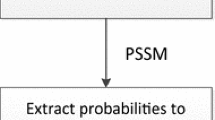Abstract
Two proteins may be structurally similar but not have significant sequence similarity. Protein fold recognition is an approach usually applied in this case. It does not rely on sequence similarity and can be achieved with relevant features extracted from protein sequences. In this paper, we experiment with the K-local hyperplane distance nearest-neighbor algorithm [8] applied to the protein fold recognition and compare it with other methods. Preliminary results obtained on a real-world dataset [3] demonstrate that this algorithm can outperform many other methods tested on the same dataset.
Similar content being viewed by others
References
G. Bologna and R. D. Appel, “A Comparison Study on Protein Fold Recognition,” Proceedings of the 9th International Conference on Neural Information Processing, Singapore, 2002, pp. 2492–2496.
I.-F. Chung, C.-D. Huang, Y.-H. Shen, and C.-T. Lin, “Recognition of Structure Classification of Protein Folding by NN and SVM Hierarchical Learning Architecture,” in Lecture Notes in Computer Science (Artificial Neural Networks and Neural Information Processing—ICANN/ICONIP 2003, Istanbul, Turkey), Ed. by O. Kaynak, E. Alpaydin, E. Oja, and L. Xu (Springer, Berlin, 2003), Vol. 2714, pp. 1159–1167.
C. H. Q. Ding and I. Dubchak, “Multiclass Protein Fold Recognition Using Support Vector Machines and Neural Networks,” Bioinformatics 17(4), 349–358 (2001).
C.-D. Huang, I.-F. Chung, N. R. Pal, and C.-T. Lin, “Machine Learning for Multiclass Protein Fold Classification Based on Neural Networks with Feature Gating,” in Lecture Notes in Computer Science (Artificial Neural Networks and Neural Information Processing—ICANN/ICONIP 2003, Istanbul, Turkey), Ed. by O. Kaynak, E. Alpaydin, E. Oja, and L. Xu (Springer, Berlin, 2003), Vol. 2714, pp. 1168–1175.
L. Lo Conte, B. Ailey, T. J. P. Hubbard, et al., “SCOP: a Structural Classification of Proteins Database,” Nucleic Acids Res. 28(1), 257–259 (2000).
N. R. Pal and D. Chakraborty, “Some New Features for Protein Fold Recognition,” in Lecture Notes in Computer Science (Artificial Neural Networks and Neural Information Processing—ICANN/ICONIP 2003, Istanbul, Turkey), Ed. by O. Kaynak, E. Alpaydin, E. Oja, and L. Xu (Springer, Berlin, 2003), Vol. 2714, pp. 1176–1183.
S. Y. M. Shi and P. N. Suganthan, “Feature Analysis and Classification of Protein Secondary Structure Data,” in Lecture Notes in Computer Science (Artificial Neural Networks and Neural Information Processing—ICANN/ICONIP 2003, Istanbul, Turkey), Ed. by O. Kaynak, E. Alpaydin, E. Oja, and L. Xu (Springer, Berlin, 2003), Vol. 2714, pp. 1151–1158.
P. Vincent and Y. Bengio, “K-Local Hyperplane and Convex Distance Nearest-Neighbor Algorithms,” in Advances in Neural Information Processing Systems, Ed. by T. G. Dietterich, S. Becker, and Z. Ghahramani (MIT, Cambridge, MA, 2002), Vol. 14, pp. 985–992.
Author information
Authors and Affiliations
Additional information
This article was submitted by the author in English.
Rights and permissions
About this article
Cite this article
Okun, O.G. K-local hyperplane distance nearest-neighbor algorithm and protein fold recognition. Pattern Recognit. Image Anal. 16, 19–22 (2006). https://doi.org/10.1134/S1054661806010068
Received:
Issue Date:
DOI: https://doi.org/10.1134/S1054661806010068




